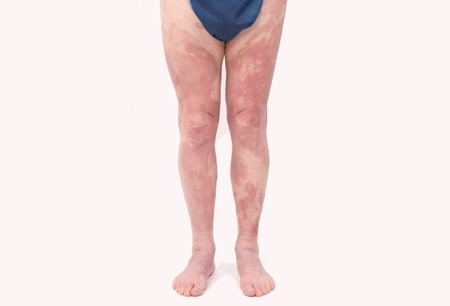Summary
Definition
History and exam
Key diagnostic factors
- manchas, placas ou tumores cutâneos
- poiquiloderma
- eritroderma
Other diagnostic factors
- prurido
- lesões cutâneas hipopigmentadas/hiperpigmentadas
- envolvimento unilesional das extremidades
- linfadenopatia
- sintomas constitucionais
- queratoderma palmoplantar
- alopécia
- face leonina
- onicodistrofia
- hepatomegalia
- ectrópio
- lesões bulhosas, granulomatosas, ictiosiformes e purpúreas
Risk factors
- idade >50 anos
- sexo masculino
- etnia negra (MF); etnia branca (SS)
- exposição a agentes infecciosos
- exposição à luz ultravioleta
Diagnostic tests
1st tests to order
- Hemograma completo
- biópsia de pele
- rearranjo clonal do receptor de células T
- citometria de fluxo
- perfil metabólico completo
- TFHs
- concentração sérica de lactato desidrogenase
Tests to consider
- exame para células de Sézary no esfregaço
- sorologia para o vírus linfotrópico de células T humanas (HTLV)-I/2
- biópsia da medula óssea
- biópsia de linfonodos
- TC ou PET
- teste de HIV
Treatment algorithm
doença em estádio IA: envolvimento limitado da pele isolado a <10% da área de superfície corporal (sem transformação em grandes células)
doença em estádio IB a IIA: doença de pele apenas com ≥10% da área de superfície corporal (sem transformação de grandes células)
doença em estádio IIB: doença tumoral e sem eritrodermia (sem transformação em grandes células)
doença em estádio III: eritrodérmica (sem transformação em grandes células)
doença em estádio IV: síndrome de Sézary em estádio IVA1 ou IVA2 (sem transformação em grandes células)
doença em estádio IV: não síndrome de Sézary em estádio IVA2 ou doença visceral/órgão sólido em estádio IVB (sem transformação em grandes células)
transformação em grandes células
doença em estádio IIB, III, IV: refratária a múltiplas terapias anteriores (sem transformação em grandes células)
Contributors
Authors
Robert A. Schwartz, MD, MPH
Professor and Head
Department of Dermatology
Rutgers New Jersey Medical School
Newark
NJ
Disclosures
RAS declares that he has no competing interests.
W. Clark Lambert, MD, PhD
Professor and Associate Head, Dermatology
Director, Dermatopathology
New Jersey Medical School
Newark
NJ
Disclosures
WCL declares he has no competing interests
Acknowledgements
Professor Robert A. Schwartz and Professor W. Clark Lambert would like to gratefully acknowledge Professor Tim M. Illidge, Dr Richard Cowan, and Dr Eileen Parry, previous contributors to this topic.
Disclosures
TMI, RC, and EP all declare that they have no competing interests.
Peer reviewers
Chris Kelsey, MD
Assistant Professor
Department of Radiation Oncology
Duke University School of Medicine
Durham
NC
Disclosures
CK declares that he has no competing interests.
Peer reviewer acknowledgements
BMJ Best Practice topics are updated on a rolling basis in line with developments in evidence and guidance. The peer reviewers listed here have reviewed the content at least once during the history of the topic.
Disclosures
Peer reviewer affiliations and disclosures pertain to the time of the review.
References
Key articles
Gilson D, Whittaker SJ, Child FJ, et al. Joint British Association of Dermatologists and UK Cutaneous Lymphoma Group guidelines for the management of primary cutaneous T-cell lymphomas. Br J Dermatol. 2019 Mar;180(3):496-526.Full text Abstract
Willemze R, Hodak E, Zinzani P, et al; ESMO Guidelines Working Group. Primary cutaneous lymphomas: ESMO clinical practice guidelines for diagnosis, treatment and follow-up. Ann Oncol. 2018 Oct 1;29(4 suppl):iv30-40.Full text Abstract
National Comprehensive Cancer Network. NCCN clinical practice guidelines in oncology: primary cutaneous lymphoma [internet publication].Full text
Reference articles
A full list of sources referenced in this topic is available to users with access to all of BMJ Best Practice.

Differentials
- Psoríase
- Eczema
- Infecção dermatofítica
More DifferentialsGuidelines
- Suspected cancer: recognition and referral
- NCCN clinical practice guidelines in oncology: hematopoietic cell transplantation
More GuidelinesLog in or subscribe to access all of BMJ Best Practice
Use of this content is subject to our disclaimer